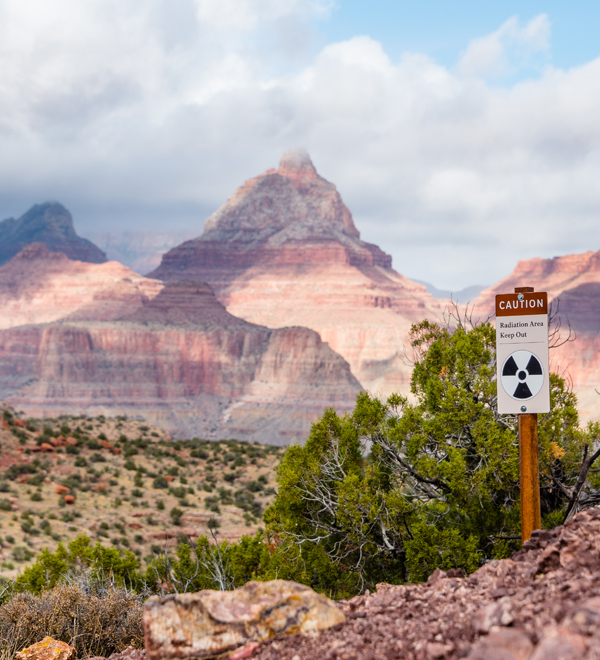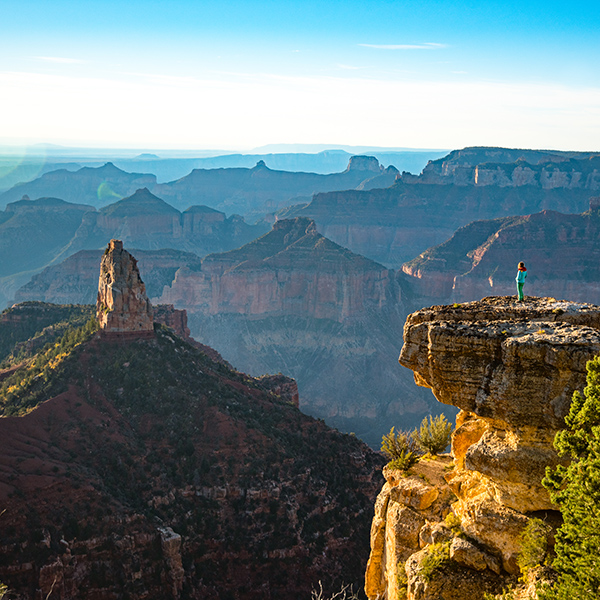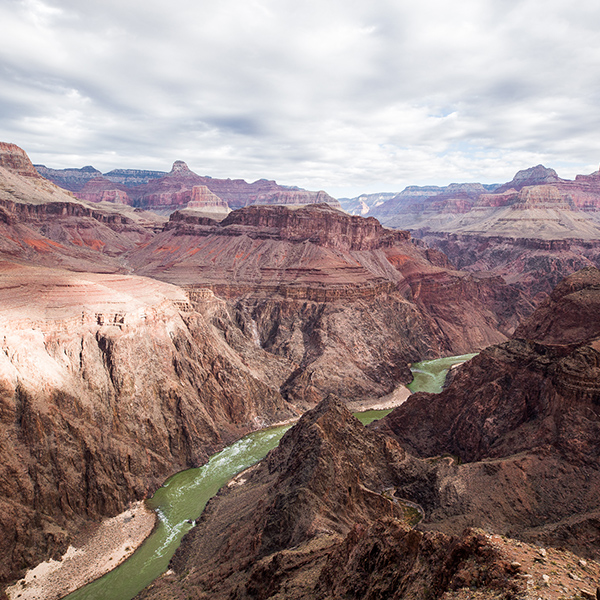The roundtrip hike to Clear Creek requires a four-day backpacking trip — one day to get down to Bright Angel Campground, another day to get to Clear Creek (described here), and an additional two days to retrace your steps back to the rim. If you’re staying at the campground or Phantom Ranch for more than one night, you can day hike a few miles up the Clear Creek trail, enjoy fantastic canyon views, then return to camp. You must get a backcountry camping permit through the Backcountry Office.
Note: all mileages in this description are from the Bright Angel Campground.
Climbing to Phantom Overlook
After getting a good night’s rest at Bright Angel Campground, begin up the North Kaibab Trail past Phantom Ranch. Stroll along Bright Angel Creek until you reach a trail junction around 0.8 mile where you turn right onto the Clear Creek Trail. You immediately start climbing up the side of a gully, switchbacking to a saddle.
Every step in the canyon affords astounding scenery, and this trail is no different. The view from the saddle overlooks Bright Angel Canyon, the craggy inner gorge, and the layers of limestone, shale, and sandstone that stack up one vertical mile to the South Rim. Compared to the park’s main corridor trails (South Kaibab, Bright Angel, North Kaibab), this backcountry route is more rugged, exposed, and narrow.
The trail continues southeast, curving around a basin up a steady grade. A long switchback leads to Phantom Overlook at 1.4 miles, a landing area built by the Civilian Conservation Corps around 1935. Their trail reinforcements still hold today, along with two stone benches they built into the cliffs. Views surround you in all directions — try to spot hikers on the South Kaibab Trail to the south, and scan the creek to the west to find the brown roofs at Phantom Ranch. If you’re day hiking, continue another half mile up the trail for even better vistas.
Past Zoroaster and Brahma Temples
As you leave Phantom Overlook, the trail turns north in a sharp switchback up Bright Angel Canyon. The steep grade mellows as you curve around the base of the Tapeats Sandstone into the main river corridor, where a striking panorama of the Colorado River awaits.
From here on, the trail mostly contours above the river as you head east. You hug the cliffs for about a mile heading towards Sumner Butte. The trail climbs to the top of the Tonto Platform as it crosses Sumner Wash; cairns on both sides of the trail signify that camping is allowed east of this point.
With the river now out of sight, Zoroaster Temple dominates the landscape. A white pyramid caps the hollowed crimson walls that end at Bradley Point to the east. The trail crosses several minor drainages over the next few miles as you contour along the Tonto Platform.
The red cliffs bend around to another promontory, Demaray Point. While you can see the Clear Creek drainage ahead of you, much stands between you and your destination — 4 miles, a canyon, and drainage are hidden in what looks like a great chasm. The trail turns north at Demaray Point and heads towards Brahma Temple, the rounded white crown set amongst the red cliffs in the distance. You parallel Zoroaster Canyon, crossing at its head and continuing east along the Tonto Platform. Wind around one last drainage near 7.5 miles before you descend into Clear Creek.
Down slippery slopes
The trail turns north, briefly paralleling Clear Creek. You start your final descent around 9 miles with switchbacks leading down slopes of Hakatai Shale to the creek bottom. This red-orange rock gets its fiery color from oxidizing iron minerals. The last few switchbacks involve the most exposure of this whole hike—loose scree slides beneath you on a trail that is only as wide as your foot.
When you reach the bottom, the trail spits you into a dry creekbed. Continue downstream a few hundred feet to the confluence with Clear Creek. Along the way, you pass a composting toilet tucked deep in vegetation on the right creek bank. Cottonwood trees shade several campsites on the bench above the creek. Be sure to filter water from Clear Creek before drinking.
Some people choose to continue another 5 miles upcreek to Cheyava Falls, which flows in wet years, or another 6 miles downcreek to the Colorado River. Check with the park service for exact mileages, current conditions, water reliability, and trip reports.
The Clear Creek trail starts at the bottom of the Grand Canyon, so you must use one of the park’s three rim-to-river trails to access the trailhead. You can start from the North Rim and hike down the North Kaibab Trail, or opt to begin at the South Rim and use either the Bright Angel or South Kaibab trails.
Join the Grand Canyon Trust today to receive your adventure kit:

Water is life in the Grand Canyon, but uranium mines located on public land mere miles from the North and South Rims threaten to contaminate the Grand Canyon's waters. The Park Service warns hikers not to drink out of several creeks along the Tonto Trail because of contamination from a uranium mine that closed in 1969.

The future of the Grand Canyon is in your hands. Will you donate today to help protect it forever?

Find out about opportunities to speak up for the Grand Canyon when it needs you most.
Don't let a little snow keep you from visiting the Grand Canyon. Here's everything you need to know for a winter trip to the big ditch.
Read MoreFind out where to camp beneath the stars in and around Grand Canyon National Park.
Read MoreSettle in to see one of the most awe-inspiring landscapes in the world transform under an expansive, colorful sky.
Read More